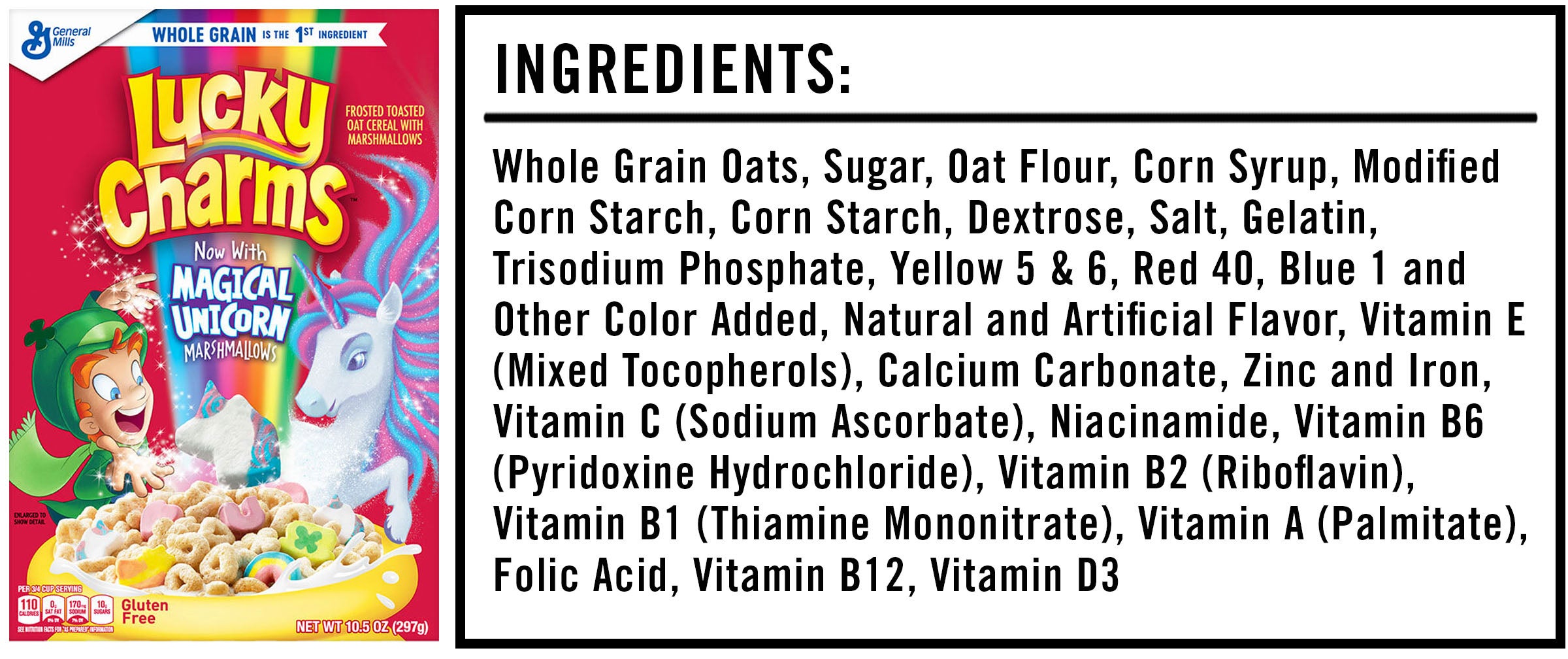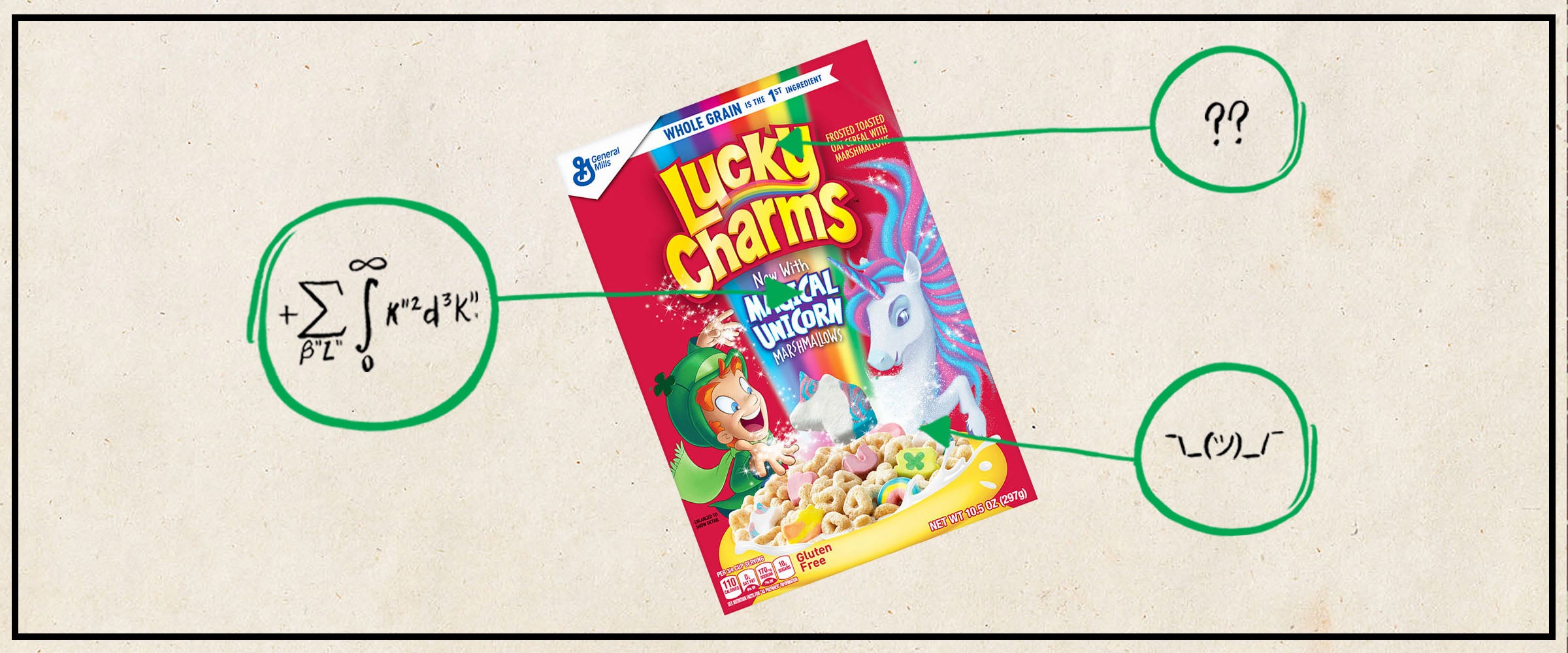
It’s St. Patrick’s Day, which means a tide of green-clad frat bros have probably already kicked down your front door and puked in your shoes. This survival guide is designed to get you through the worst day of the year in as few pieces as possible.
We’re often told that you should never eat anything (or put anything on your body) if you don’t recognize everything on the ingredients list. But since most of us have no idea what xanthan gum or potassium benzoate are — or more importantly, what they’re doing to our bodies — we’re decoding the ingredients in the many things Americans put in (and on) themselves with the help of an expert.
This edition: Lucky Charms, which are made from 26 separate ingredients that we’ve broken down in the exact order they appear on their website.
The Ingredients
1) Whole Grain Oats: Whole grain oats are unrefined, which means the bran (the outer layer) and the germ (the reproductive seed) aren’t removed through milling. As a result, whole grain oats are much better sources of fiber and other nutrients (including B vitamins that help with basically every bodily function) than refined oats.
2) Sugar: One serving (just three-quarters of a cup, which, lol!) of Lucky Charms contains 10 grams of sugar, which is a considerable amount considering how much we actually eat. The American Heart Association recommends that men consume no more than 36 grams and that women consume no more than 25 grams of added sugar per day.

Too much sugar, if you didn’t already know, is terrible for you: A sugar-laden diet is associated with all kinds of ailments, from heart disease to depression. But then again, this cereal has fucking marshmallows in it — what did you expect?
3) Oat Flour: Oat flour is a powder made from grinding oats. It’s usually added to processed foods (like this cereal) as a thickener.
4) Corn Syrup: Corn syrup is a liquid sweetener made of glucose. It doesn’t get as much negative publicity as high-fructose corn syrup — which has been linked to obesity and diabetes by many, many studies (more on that here) — but regular corn syrup can also be debilitating, considering it’s basically liquid sugar.
5) Modified Corn Starch: Modified corn starch is (obviously) extracted from corn, then treated physically, enzymatically or chemically to partially break down the starch. It’s typically used as a batter to give foods a light, crispy texture.
6) Corn Starch: This is ground up corn grain. It’s gluten-free and primarily acts as a bulking agent.
7) Dextrose: Dextrose is a sugar derived from starches, like corn. Fun fact: Dextrose has a high glycemic index, meaning it quickly raises blood sugar levels, so it’s used in IV solutions to treat low blood sugar and dehydration. People with diabetes might also consume dextrose tablets to raise their blood sugar if they become dangerously low. Because of this blood-sugar-boosting effect, consuming dextrose also provides an almost immediate jolt of energy — followed by an inevitable crash.
8) Salt: For flavor.
9) Gelatin: Gelatin is a colorless, flavorless protein derived from various animal parts, so vegetarians and vegans beware. It’s commonly used as a gelling agent. As such, it’s what makes up the bulk of the marshmallows in Lucky Charms.
10) Trisodium Phosphate: Trisodium phosphate and other sodium phosphate-based additives are commonly used in highly-processed foods to decrease acidity (which might otherwise cause spoilage) and improve texture. For instance, this ingredient can act as a leavening agent in baked goods, helping the dough rise and maintain its form.
While trisodium phosphate is generally recognized as safe by the Food and Drug Administration, diets that are high in processed foods — and therefore, probably high in phosphate-based ingredients — can potentially raise your phosphate levels to unhealthy amounts. Unfortunately, studies have linked high levels of phosphates with conditions like heart disease, decreased bone density, premature aging, kidney issues and even early death. All of which means eating Lucky Charms every single day is probably a bad idea, as if you didn’t already know that.
11) Yellows 5 & 6: Artificial colors have a bad reputation, but as physician and biochemist Cate Shanahan, author of Deep Nutrition: Why Your Genes Need Traditional Food, explained during our analysis of Doritos, studies arguing this are a bit flawed: “I’ve always been of the opinion that studies claiming artificial colors can cause cancer are irrelevant because [in the studies] they use really high amounts of the artificial colors — like, a million times more than you’d ever get [in your] food [throughout your lifetime].”
All in all, the average person’s liver should be able to break down whatever minuscule amount of artificial coloring we consume with food.
12) Red 40: See above.
13) Blue 1 and Other Color Added: Once again, see above.
14) Natural and Artificial Flavor: While natural flavors are literally flavors derived from an actual food source — i.e., grape flavoring taken from a real grape — artificial flavors are chemical compounds created in a lab that mimic a natural flavor in some way. While that may sound unhealthy, as Shanahan told us during our exploration of all 26 ingredients in those aforementioned nacho-flavored Doritos, these flavorings are added in such small quantities that they shouldn’t cause you any harm.
15) Vitamin E (Mixed Tocopherols): Tocopherols are natural antioxidants added to maintain the freshness and shelf life of products.
16) Calcium Carbonate: Many cereals are reinforced with vitamins and minerals as both a marketing ploy and (maybe) an attempt to tackle widespread nutritional deficiencies, which explains why all of the following ingredients (including this one) are vitamins and minerals.
As for calcium carbonate, it’s commonly added to cereals as a calcium supplement and can help to ease symptoms of irritable bowel syndrome. But as we learned in our study of TUMS ingredients, people who are already taking calcium supplements should avoid this ingredient, since too much calcium can result in a calcium overdose. Symptoms of such an overdose include kidney stones, fatigue, muscle weakness, nausea and vomiting, frequent urination, changes in heart rate, confusion, constipation or diarrhea, headaches and coma.
17) Zinc and Iron: These are both minerals, which is why they’re listed together. Zinc boosts the immune system, while iron supports the circulatory system.
18) Vitamin C (Sodium Ascorbate): Maintains skin, cartilage, teeth, bones and blood vessels.
19) Niacinamide: Improves cholesterol levels and lowers cardiovascular risks.
20) Vitamin B6 (Pyridoxine Hydrochloride): Helps the brain create serotonin (which regulates mood) and norepinephrine (which helps the body cope with stress).
21) Vitamin B2 (Riboflavin): Aids in the breaking down of foods and regulates energy levels.
22) Vitamin B1 (Thiamine Mononitrate): Helps the body break down carbohydrates.
23) Vitamin A (Palmitate): Supports vision and the immune system.
24) Folic Acid: Helps your body produce and maintain new cells and prevents changes to DNA that may lead to cancer.
25) Vitamin B12: Keeps nerve and blood cells healthy. Low levels of vitamin B12 have also been associated with premature ejaculation, so Lucky Charms might not be the worst choice if you’re dealing with that and hoping to get, well, lucky.
26) Vitamin D3: Helps the body absorb calcium and promotes bone growth.
The Takeaway
While Lucky Charms contain an array of vitamins and minerals in addition to somewhat healthy whole grain oats, this cereal is also drenched in sugar and corn syrup — so much so that they had to make the serving size a meager three-quarters cup, which is laughably tiny. It contains the controversial ingredient trisodium phosphate as well, which is usually a sign that the food is overprocessed, and therefore, not too healthy.
All in all — and you probably saw this coming — less processed varieties of cereal (like those made by Ezekiel, Barbara’s or Kashi) are a better choice. To put it more succinctly: Maybe you shouldn’t be eating Goddamn marshmallows for breakfast?

